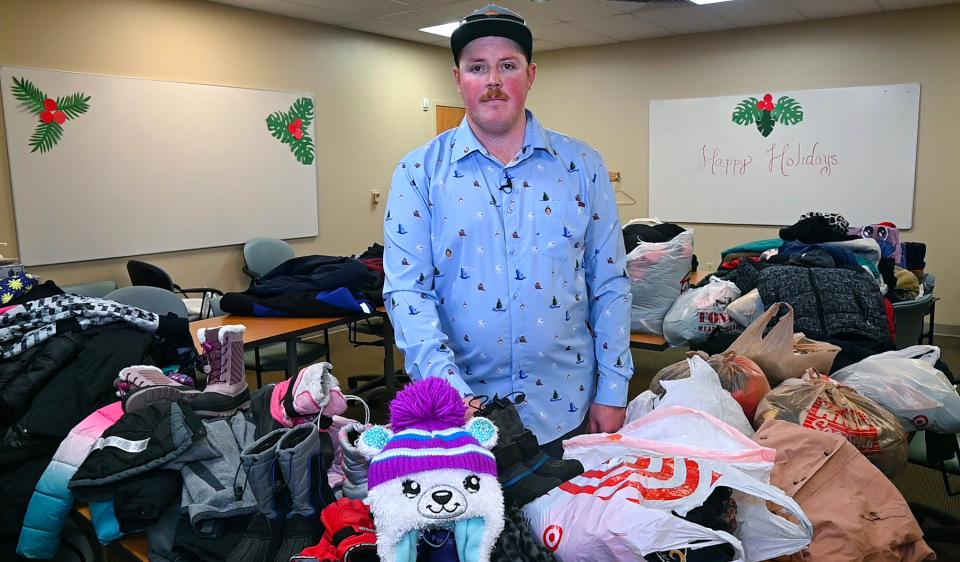This CSU grad nearly lost his toes to frostbite. Now he wants to help the homeless stay safe.
An unprepared Alec Grimes walked a couple hours wearing canvas Vans in wind chill of minus-18 degrees while visiting his brother in Fort Collins six years ago.
His toes still remind him of that wintry day. And he's fortunate for that, as he nearly lost them.
Grimes walked the 2 miles from Old Town to his brother's house wearing only canvas shoes, thin socks, jeans, a light jacket and baseball cap with no gloves. His cellphone was dead and the colder he became the more disoriented he became. He said he had not been drinking alcoholic drinks.
When he reached his brother's house, his brother sensed the urgency after looking at Alec's feet and rushed him to the emergency room at UCHealth Poudre Valley Hospital.
"When they put lukewarm water on my feet, it was pretty painful,'' said Grimes, a Colorado State University graduate. ''Then they started throwing around the idea of amputation. I was really worried.''
So were PVH doctors, who flew him by helicopter to frostbite experts at UCHealth University of Colorado Hospital on the Anschutz Medical Campus in Aurora. Doctors told him he faced a 70% to 90% chance of amputation.
Grimes said they saved his toes by giving him tPA, a drug given to dissolve clots in stroke victims. The drug works by opening blocked blood vessels and restoring blood flow.
"The blood in my feet wasn't flowing and the blood had kind of crystalized when they decided to give me the drug,'' Grimes said. "They said the drug needed to work in an hour or two to save my toes. Luckily it worked.''
More:Colorado chances of a white Christmas helped by snow, frigid wind chill
Experts warned people to avoid going outdoors for extended periods of time Thursday, Dec. 22, and Friday, Dec. 23, this week because of dangerous temperatures and wind chill values parts of the state have not seen in decades.
Wind chill values of minus-30 degrees forecast for Fort Collins late this week can cause frostbite to exposed skin in 30 minutes or less, according to the National Weather Service. Wind chill of minus-50 like the Eastern Plains are forecast to feel can cause frostbite in 10 minutes or less.
There are two lasting impacts of Grimes' frostbite experience: He suffered minor but permanent nerve damage that makes his toes sensitive to heat and cold. And he began a Bite Back Cold Weather Gear Drive that gives donated items to UCHealth patients and the community to help prevent others from experiencing cold weather-related injuries.
The first year after he nearly lost his toes, he bought socks and gloves and handed them out to those experiencing homelessness in Denver's Civic Center Park.
After that year, he greatly expanded the effort by including his employers (Johns Manville originally and currently Colorado Golf & Turf) and his mom, an elementary principal in Highlands Ranch. Now he donates the gear to the UCHealth University of Colorado Hospital Burn and Frostbite Center, which distributes the clothing to Denver homeless shelters.
"The big takeaway from my frostbite was to help the homeless because they are always exposed,'' he said. "When I saw the looks on the faces of those people the first year and how appreciative they were I knew I had to find a way to grow it.''
You can donate to the Bite Back Cold Weather Gear Drive at amazon.com/hz/wishlist/ls/21MVS0IIMYUNT?ref_=wl_share.

Symptoms, effects and how to prevent frostbite
Symptoms: Include redness or pain in the affected area, white or grayish-yellow skin, skin that feels abnormally firm or waxy, numbness, blisters or black, dead skin and tissues in severe cases.
Long-term effects: Include the possibility of change in sensation of the injured area, chronic pain, damage to sweat glands, cracking skin and nail loss, and possible amputation of damaged digits or limb.
Prevention: If someone suspects frostbite due to cold exposure:
Prevent additional exposure to the cold.
Rewarm the affected area in warm (not hot) water for 15 to 30 minutes.
Keep the affected area elevated to reduce swelling.
Use over-the-counter pain medication like ibuprofen if the affected area is painful upon warming.
Try to avoid walking on frostbitten feet.
Note: If the skin appears blue, bluish-gray or blisters form when the skin warms, it is important to seek medical attention as soon as possible to prevent further tissue damage.
Source: UCHealth University of Colorado Hospital Burn and Frostbite Center
Fort Collins activates emergency weather shelter plan
Emergency overnight shelter will be offered through Friday, Dec. 23 for those seeking a place to escape the cold. According to a city release:
Men seeking overnight shelter can join the Fort Collins Rescue Mission's bed list by visiting the shelter at 316 Jefferson St., the Murphy Center at 242 Conifer St., or by calling the rescue mission at 970-224-4302.
Women and families seeking shelter should go to Catholic Charities, 460 Linden Center Drive.
The Murphy Center's indoor day shelter will be available to all who need shelter from 8 a.m. to 5 p.m. through Friday.
This article originally appeared on Fort Collins Coloradoan: CSU grad pays it forward after nearly losing toes to frostbite

